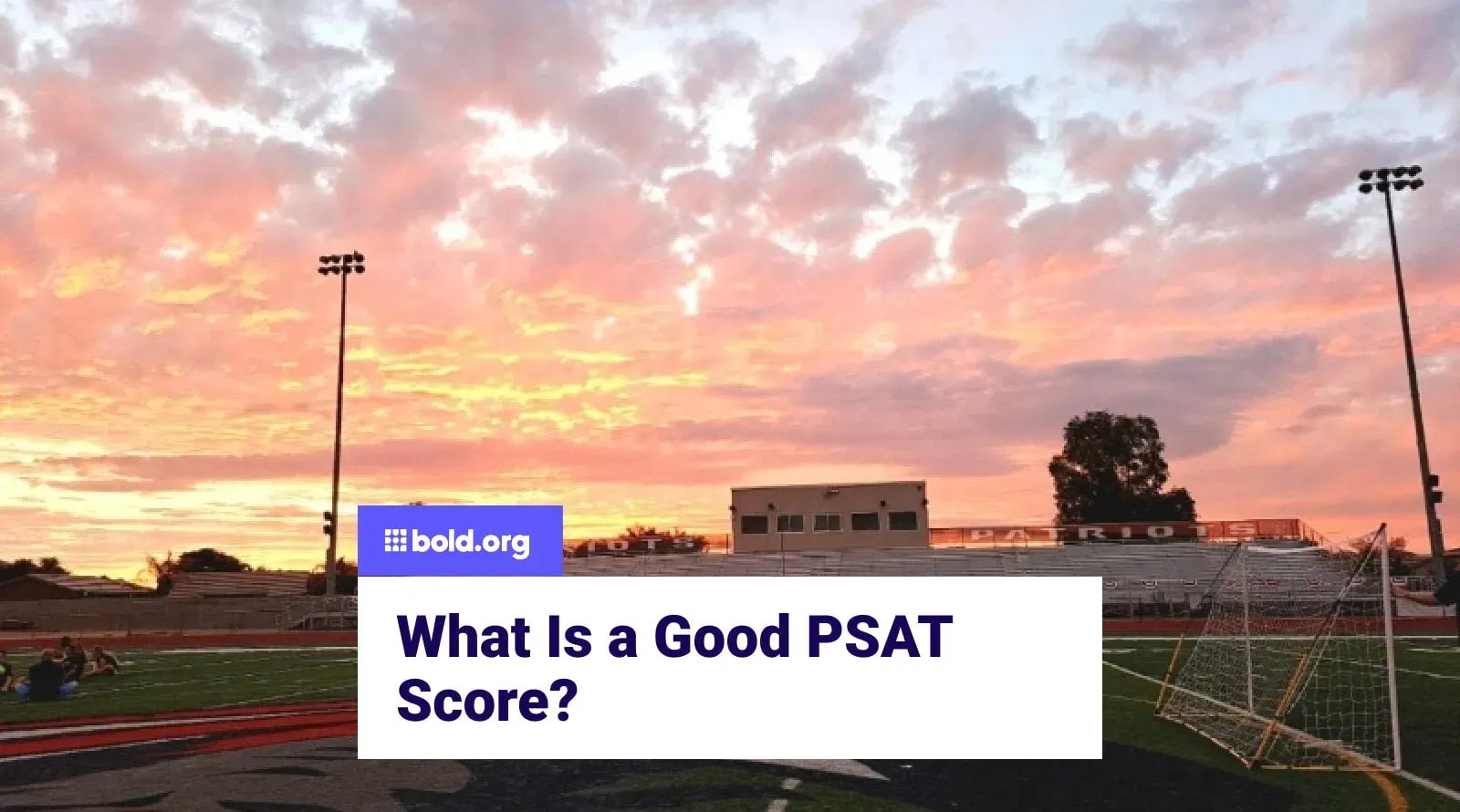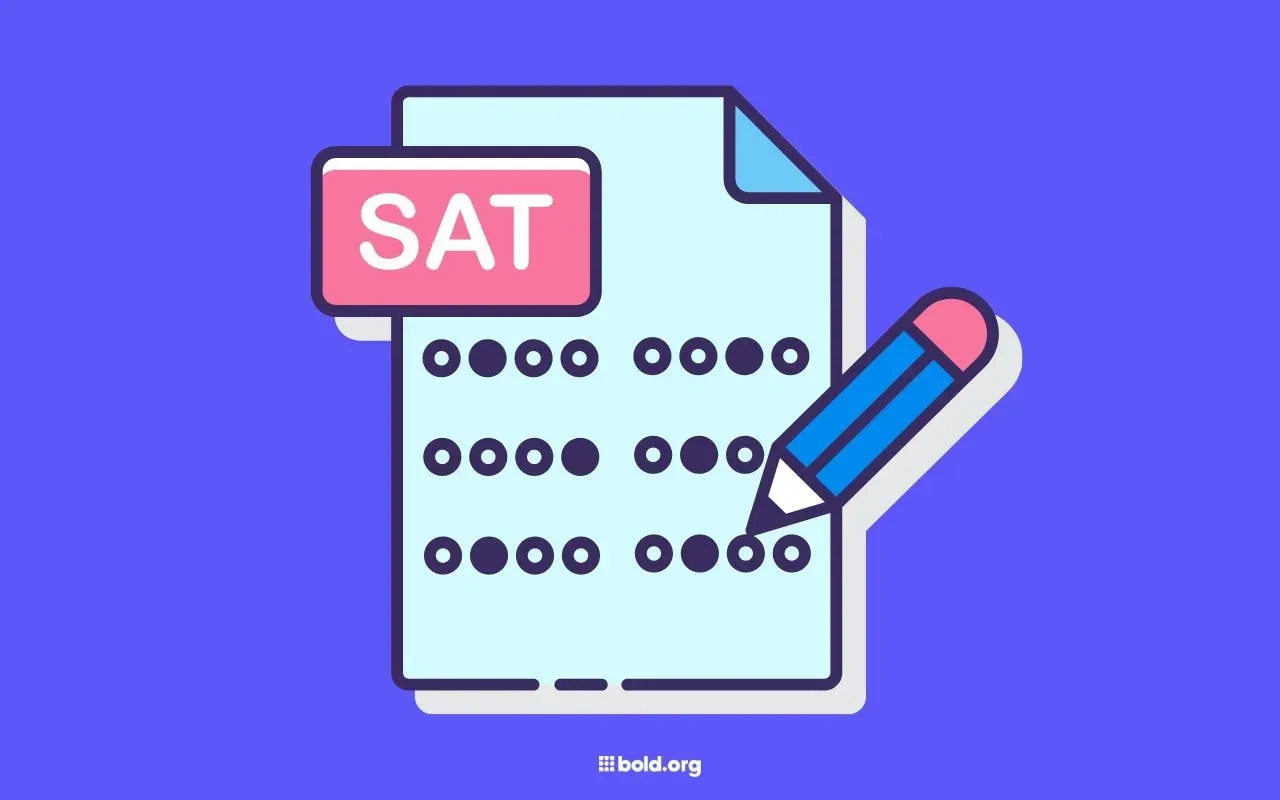PSAT to SAT Conversion Chart 2025: Predict Your Score

Standardized tests can be overwhelming, especially when it comes to understanding the PSAT to SAT Conversion. The PSAT, or Preliminary SAT, serves as both a practice test for the SAT and a qualifying test for the National Merit Scholarship.
Understanding how your PSAT scores predict your potential SAT performance can help you better prepare and set realistic goals. It's like getting a preview of how you might do on the SAT, which can give you an advantage in planning your study strategy and college selection process.
This article explores the conversion process with simplicity and accuracy through thorough research on the most recent PSAT and SAT statistics, College Board, and other standardized tests.
At Bold.org, our mission is to reduce student debt. Create a free applicant profile and start saving for the higher education you deserve!
Create Your Free Profile to Apply for Scholarships Today!PSAT and SAT Score Conversion Table
Now, without further ado, let's get into our Bold.org PSAT and SAT score conversion chart! Assembled in an easy-to-read manner and based upon the most recent PSAT and SAT exam results for the highest accuracy. Simply locate your PSAT score and find your predicted SAT score in the neighboring column!

After utilizing this PSAT to SAT conversion chart, you may want to know if your predicted SAT score is good. We've got you covered with our guide on What Is a Good SAT Score!
The Relationship Between PSAT and SAT: Explained
Understanding the relationship between the PSAT and SAT is key for students aiming to maximize their test prep efforts. Both exams serve distinct purposes but share a common thread.
Purpose, Format, and Key Differences
- PSAT (Preliminary SAT): Aptly named, the PSAT is designed as a practice version of the SAT. It helps students gauge their readiness for college admissions tests.
- SAT: A standardized test widely used for college admissions in the United States. Measures literacy, numeracy, and writing skills.
While both tests cover similar content areas—reading, writing, and math—the SAT includes an optional essay section. The PSAT also has slightly fewer questions and a shorter duration.
Introduction to PSAT 10 and PSAT/NMSQT
You may also be surprised to learn that there are two versions of the PSAT, and both can be important in guaging your predicted SAT score.
- PSAT 10: Typically taken by sophomores in high school. It's identical in structure to the PSAT/NMSQT but does not qualify students for scholarships.
- PSAT/NMSQT (National Merit Scholarship Qualifying Test): Primarily aimed at juniors. This version is not just a practice test but also a qualifying exam for the National Merit Scholarship Program.
Both versions of the PSAT are critical stepping stones toward acing the SAT. They provide valuable feedback through detailed score reports that highlight strengths and areas needing improvement.
Get Matched to Thousands of Scholarships
Create your Bold.org profile to access thousands of exclusive scholarships, available only on Bold.org.
Create Free ProfileThe Benefits of a High PSAT Score
Scoring well on the PSAT doesn't just show that you're ready for the SAT; it can also lead to exciting opportunities like the National Merit Scholarship. This scholarship program uses PSAT/NMSQT scores as a basis for awarding financial aid and recognition, making all those hours of studying worth it.
If you're taking the PSAT and SAT, chances are you're a high school student getting started on the college application process. Don't miss out on these exclusive high school scholarships designed to help you save!

Understanding the Scoring Systems
Understanding how the PSAT and SAT are scored can be confusing at first. But don't worry, we'll break it down for you.
PSAT Scores
Here's what you need to know about PSAT scores:
- Score Range: The PSAT is scored on a scale of 320 to 1520.
- Sections: It includes two main sections—Evidence-Based Reading and Writing (ERW) and Math.
- Subscores: Each section is further divided, providing scores that range from 160 to 760. Add your ERAW and Math section scores together and you get a total score out of 1520.
SAT Scores
And here's the scoop on SAT scores:
- Score Range: The SAT has a broader range, from 400 to 1600.
- Sections: Like the PSAT, it also focuses on ERW and Math but includes an optional Essay section (scored separately). This makes it much more of a writing and language test than the PSAT.
- Subscores: Each main section score ranges from 200 to 800. Add the two section scores together gives you a maximum of 1600.

Impact of Scoring Scale Differences
Understanding the impact of these scoring differences is crucial for accurate PSAT to SAT conversion.
1. Direct Conversion Isn't Perfect
The highest possible score on the PSAT is 1520, while on the SAT, it's 1600. This means that getting a perfect score on the PSAT doesn't guarantee a perfect SAT score.
2. Scaled Scores vs Raw Scores
Both tests convert raw scores (the actual number of questions correctly answered) into scaled scores through a process called equating. This adjusts for slight differences in difficulty across test forms. You may already be familiar with this process if your teacher curves the entire class' grades after a particularly difficult exam.
3. Predictive Validity
It may be enticing to simply multiply your PSAT score by a factor of 1.05 but this doesn't accurately get you to your predicted SAT score. Both the PSAT and SAT are designed against a bell curve where it becomes exponentially harder to reach the perfect 1520 or 1600. This means that an even ratio for PSAT to SAT conversion isn't possible.
Understanding these details will make it easier to see how your practice test performance relates to your actual test day outcomes without any wild guessing games.
Don't forget to browse through our selection of blog posts on other standardized tests to enhance your college application!

Predicting Your SAT Score from PSAT Performance
Curious about how your PSAT score translates to the SAT? Colleges often use percentiles as a key tool for estimating SAT scores from PSAT results. Here's a closer look at how this works.
Percentiles and Their Role
Percentiles are like a ranking system that shows how you performed compared to other test-takers. For example, scoring in the 85th percentile on the PSAT means you scored higher than 85% of students who took the test. Colleges use these percentiles to gauge your future SAT score, as they provide a snapshot of where you stand academically among your peers.
Score Ranges: Bridging the Gap
The relationship between percentiles and score ranges is essential for making accurate predictions. While College Board no longer provides concordance tables that link PSAT scores to their corresponding SAT ranges, you can find old ones such as this 2007-2008 dataset. Even though these tables aren't crystal balls, they offer a reliable estimate of target scores. For instance:
- A PSAT score of 1200 might predict an SAT score in the range of 1250-1350.
- Scoring 1400 on the PSAT could suggest an SAT score between 1450-1550.
These estimates consider various factors, including the different scoring scales and difficulty levels of each test. If you want further insight into the SAT score structure, check out some other concordance tables offered by College Board!
Drowning in practice tests while gearing up for the upcoming SAT exam? Check out our comprehensive guide on how to study for the SAT!
The Role of SAT in College Admissions
The SAT plays a significant role in the college admissions process. It acts as a standardized tool to compare students from different educational backgrounds. By assessing critical reading, writing, and math skills, this test provides colleges with a common way to evaluate academic and college readiness in high school students.
Why the SAT Matters
- Standardization: Unlike high school GPAs, which can vary significantly between schools and regions, the SAT offers a uniform metric that colleges trust.
- Holistic Review: For many institutions, SAT scores complement other application materials like essays, extracurriculars, and recommendation letters. Bear in mind that SATs are simply another part of a college's holistic evaluation.
- Scholarship Opportunities: High SAT scores often unlock merit-based scholarships, making higher education more affordable.
Impact of Test-Optional Policies
- Growing Trend: An increasing number of colleges are adopting test-optional policies. This means applicants can choose whether to submit their SAT scores.
- Applicant Considerations: Students with strong test scores might still benefit from submitting them, as it can strengthen their application. Conversely, those who feel their scores don’t reflect their true potential can opt-out.
- Institutional Flexibility: Test-optional policies allow colleges to attract a broader range of applicants, promoting diversity and inclusion within their student body.
While the importance of the SAT remains substantial, test-optional policies offer students greater flexibility in showcasing their strengths.
If you're still feeling nervous about standardized tests and the college application process in general, this complete guide to the college admissions process is for you!
The National Merit Scholarship Program and its Ties to the PSAT/NMSQT
The National Merit Scholarship Program is a prestigious academic competition that recognizes and rewards high-achieving students. This program is highly regarded by colleges and can significantly enhance a student's academic profile.
Eligibility Criteria Based on PSAT/NMSQT Scores
Eligibility for this scholarship begins with taking the PSAT/NMSQT (Preliminary SAT/National Merit Scholarship Qualifying Test). Students must achieve a top percentile score on their PSAT to qualify as National Merit Semifinalists. Each state has its own qualifying score, making the process competitive yet attainable for diligent students.
Benefits for Students Who Receive the Scholarship
Earning the title of National Merit Scholar opens many doors:
- Financial Aid: Scholars can receive significant scholarships, sometimes covering full tuition.
- College Admissions: Being a National Merit Scholar enhances college applications, showcasing academic excellence.
- Recognition: Scholars gain national recognition, which can lead to additional opportunities and honors.
Understanding how your PSAT performance ties into these opportunities underscores the importance of taking the test seriously.
Scoring well on the PSAT or SAT is one thing, but being able to afford your dream college is another. Browse through our thousands of scholarships to ensure finances won't be holding you back from fulfilling your true academic potential!

Frequently Asked Questions About PSAT to SAT Score Conversion
Is the PSAT harder than the SAT?
No, the PSAT is generally considered less difficult than the SAT. The questions on the PSAT are slightly easier, and the test is shorter in duration. The purpose of the PSAT, which has an identical test format, is to give students a preview of what to expect on the SAT, making it an excellent practice tool.
Does my PSAT score matter for college admissions?
While your PSAT score itself isn't used in college admissions, it can be a valuable indicator of your potential SAT performance. High scores on the PSAT can qualify you for the National Merit Scholarship Program, which can significantly bolster your college application.
What SAT score will get me into an Ivy League?
Getting into an Ivy League school typically requires SAT scores in the top percentiles. Generally, scores above 1500 out of 1600 are expected, and an SAT score of 1550+ will generally place you in the top 75% of Ivy League students. However, admissions committees consider many factors beyond test scores, including extracurricular activities, essays, and letters of recommendation.
Pro Tip: Use your PSAT results to identify areas for improvement before taking the SAT. This strategic approach can help you achieve a competitive score.
If you have any more questions about exams, studying, or anything education-related, check out our scholarship blog, created by and for students!